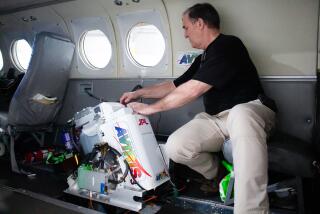Swiss ‘janitor satellite’ would dispose of space debris
- Share via
Outer space is about to get its first janitor satellite.
Engineers from the Swiss Space Center at the Ecole Polytechnique Federale de Lausanne announced this week that they soon will begin work on CleanSpace One, a prototype for a line of brand-new satellites whose sole mission will be to remove defunct satellites from orbit.
If the prototype is successful, the EPFL hopes to create a family of “de-orbiting” satellites so that humanity can practice in space what the Boy Scouts preach here on Earth — take only pictures (or data readings), leave only footprints (or space trails?)
But it won’t be simple. Objects in orbit around the Earth are moving at speeds of up to 17,500 mph, making them ticking time bombs for whatever they might collide with. At that velocity, even a fleck of paint has the kinetic energy of a hand grenade going off, according to Donald J. Kessler, a retired senior scientist for orbital debris research at NASA.
For CleanSpace One to grab and destroy a defunct satellite, it first will have to match its target’s orbital plane with the help of an ultra-compact space motor. Then, when it gets within range of its target, it will grab the other satellite with some sort of gripping mechanism that is still to be determined, and try to stabilize it.
Once the two are coupled, the selfless cleaner satellite will perform a suicide mission — hurling the defunct satellite and itself into the Earth’s atmosphere, where the two satellites will burn into oblivion.
It’s a noble death for an inanimate object, but removing one bit of space junk is just the tip of the space debris iceberg.
According to NASA, there are more than 20,000 pieces of space debris orbiting the Earth that are larger than a softball and more than 500,000 pieces larger than a marble.
ALSO:
Beam, the smartphone-compatible toothbrush
Nomophobia--fear of being without your phone--is on the rise
Space junk expert on why NASA should clean up space--and how
More to Read
Inside the business of entertainment
The Wide Shot brings you news, analysis and insights on everything from streaming wars to production — and what it all means for the future.
You may occasionally receive promotional content from the Los Angeles Times.











